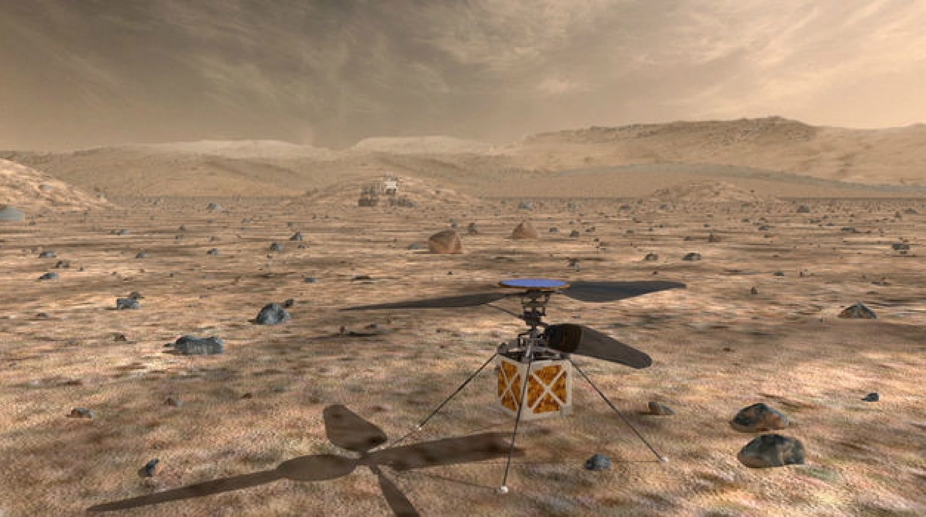Touching the Sun
The Sun, the fiery heart of our solar system, has fascinated humanity for centuries. Despite the progress of modern science, many of its secrets remain locked away, particularly the mysteries of its outer atmosphere, the corona.
NASA has confirmed it is sending an autonomous helicopter to Red Planet that will travel with the Mars rover mission, currently scheduled to launch in July 2020.

This handout illustration obtained May 11, 2018 courtesy of NASA shows an illustration of NASA's Mars Helicopter, a small, autonomous rotorcraft, will travel with the agency’s Mars 2020 rover mission, currently scheduled to launch in July 2020, to demonstrate the viability and potential of heavier-than-air vehicles on the Red Planet. (Photo: AFP PHOTO / NASA / JPL-CALTECH)
NASA has confirmed it is sending an autonomous helicopter to Red Planet that will travel with the Mars rover mission, currently scheduled to launch in July 2020.
The small, lightweight Mars Helicopter will demonstrate the viability and potential of heavier-than-air vehicles on the Red Planet.
Advertisement
“The idea of a helicopter flying the skies of another planet is thrilling. The Mars Helicopter holds much promise for our future science, discovery, and exploration missions to Mars,” NASA Administrator Jim Bridenstine said in a statement on Friday.
Advertisement
Started in August 2013 as a technology development project at NASA’s Jet Propulsion Laboratory (JPL), the Mars Helicopter weighs at 1.8 kgs.
Its fuselage is about the size of a softball, and its twin, counter-rotating blades will bite into the thin Martian atmosphere at almost 3,000 rpm — about 10 times the rate of a helicopter on Earth.
“It’s fitting that the US is the first nation in history to fly the first heavier-than-air craft on another world,” said Representative John Culberson (Texas).
The chopper will attempt controlled flight in Mars’ thin atmosphere.
The helicopter has built-in capabilities needed for operation at Mars, including solar cells to charge its lithium-ion batteries, and a heating mechanism to keep it warm through the cold Martian nights.
“Exploring the Red Planet with NASA’s Mars Helicopter exemplifies a successful marriage of science and technology innovation and is a unique opportunity to advance Mars exploration for the future,” said Thomas Zurbuchen, Associate Administrator for NASA.
The altitude record for a helicopter flying on Earth is about 40,000 feet.
“The atmosphere of Mars is only one per cent that of Earth, so when our helicopter is on the Martian surface, it’s already at the Earth equivalent of 100,000 feet up,” said Mimi Aung, Mars Helicopter project manager at JPL.
“To make it fly at that low atmospheric density, we had to scrutinize everything, make it as light as possible while being as strong and as powerful as it can possibly be,” Aung added.
Once the rover is on the planet’s surface, a suitable location will be found to deploy the helicopter down from the vehicle and place it onto the ground.
The rover then will be driven away from the helicopter to a safe distance from which it will relay commands.
After its batteries are charged and a myriad of tests are performed, controllers on Earth will command the Mars Helicopter to take its first autonomous flight into history.
“We don’t have a pilot and Earth will be several light minutes away, so there is no way to joystick this mission in real time,” said Aung.
The full 30-day flight test campaign will include up to five flights of incrementally farther flight distances, up to a few hundred meters, and longer durations as long as 90 seconds, over a period.
On its first flight, the helicopter will make a short vertical climb to 10 feet, where it will hover for about 30 seconds.
Mars 2020 will launch on a United Launch Alliance (ULA) Atlas V rocket from Space Launch Complex 41 at Cape Canaveral Air Force Station in Florida, and is expected to reach Mars in February 2021.
The rover will conduct geological assessments of its landing site on Mars, determine the habitability of the environment, search for signs of ancient Martian life, and assess natural resources and hazards for future human explorers.
Advertisement